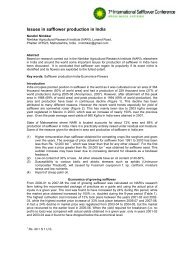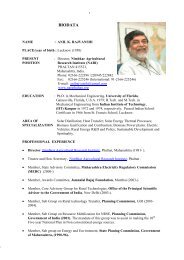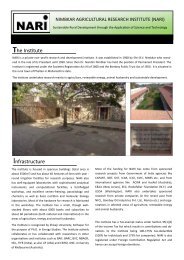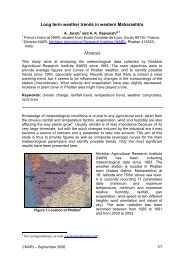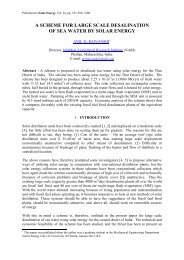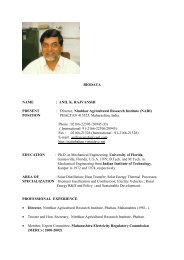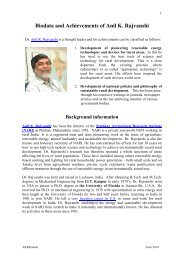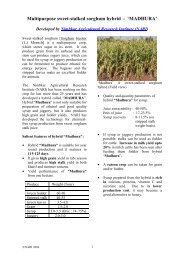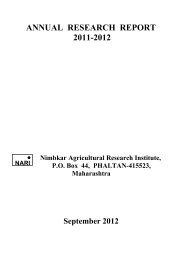3639_C006.fm Page 188 Wednesday, July 19, 2006 1:30 PM188 GENETIC RESOURCES, CHROMOSOME ENGINEERING, AND CROP IMPROVEMENTunsuccessful. Mundel et al. (2004) reported that a Calgary-based company, SemBioSys Genetics,Inc., genetically transformed safflower tissue to produce the modified protein of interest in theseeds. It is indicated that transgenic safflower has a fair chance of getting permission for commercialcultivation in North America, as it has relatively low acreage and no weedy relatives with whomit can cross to produce fertile hybrids. In addition, safflower has several inherent agronomic qualitiessuch as a low tendency to weediness, low seed dormancy, and large degree of self-pollination,which translates into a system that is quite easy to confine so that target products do not minglewith food or feed and thus make it a lower-risk production platform.6.9 POLYEMBRYONY AND APOMIXIS IN SAFFLOWERExistence of polyembryony, like that in many plant species, has been observed in safflower(Singh et al., 2005). A safflower genotype D-149 with a tendency to produce twin seedlings at therate of 0.6 to 10% in its different derivatives has been identified. Thirty percent of the twin seedlingswere male sterile and did not show seed setting on crossing with fertile plants, as well as underopen pollination, and thus were considered to have a changed ploidy level and are assumed to behaploid or triploid in nature. The haploid or triploid nature of plants from twin seedlings suggeststhe presence of polyembryony, since polyembryony is known to produce haploids/triploids andthese in general are reported to be male sterile in nature. Efforts are under way to examine thefeasibility of its utilization for cultivar development in safflower.Apomixis is yet to be confirmed in safflower, though preliminary studies carried out at theNimbkar Agricultural Research Institute (<strong>NARI</strong>) at Phaltan in India indicate the possibility ofexistence of apomixis in safflower. Cytological and breeding investigations are under way at <strong>NARI</strong>to confirm the presence of apomixis in safflower.6.10 FUTURE DIRECTIONInformation on genetic and linkage maps in safflower is completely lacking, and it needs immediateattention because this will help breeders to manipulate genes controlling different traits and to evolvenew genotypes and cultivars with improved productivity and resistance to biotic and abiotic factors.The lack of homology between the chromosomes of cultivated safflower (C. <strong>tinctorius</strong>) with 2n = 24and the species with other than 2n = 24 chromosomes has prevented introgression of desirablegenes from the wild relatives to the cultivated types. Modern techniques like embryo rescue andother biotechnological tools may play an important role in overcoming such barriers. Developmentof a cytoplasmic-genetic male sterility system for hybrid breeding, a successful outcome of ongoingefforts to use polyembryony for varietal improvement, and confirmation of apomixis in safflowerwould argue well for further efforts to translate them into reality. Flower yield and pigment contentof the flowers are the other traits that have gained economic importance recently, due to an increasingdemand for safflower flowers as a source of natural food color in European and other Westerncountries and their use in medicines for curing several chronic diseases. No attention has been paidto improvement of these traits in safflower. The improvement in yield of flowers and pigments inflowers would certainly help in increasing total remuneration from the crop to the farmer. Genetictransformation of safflower to impart resistance to biotic and abiotic factors, in addition to developmentof seeds with altered fatty acid and protein profiles, is another area that has received verylittle attention. Conventional breeding techniques, though used for these purposes, have not beenvery successful. Therefore, genetic modification of safflower would be of enormous importance inimproving productivity, production, and remuneration per unit area from the crop, which in turnwould certainly help in increasing safflower area in the world.
3639_C006.fm Page 189 Wednesday, July 19, 2006 1:30 PMSAFFLOWER (CARTHAMUS TINCTORIUS L.) 189REFERENCESAU: Pleasespell out.Abel, G.H. and D.G. Lorance. 1975. Registration of ‘Dart’ safflower. Crop Sci. 15: 100.Anjani, K. 2000. Components of seed yield in safflower (<strong>Carthamus</strong> <strong>tinctorius</strong>). Indian J. Agric. Sci.70: 873–875.Anonymous. 1976–1977. Tenth Annual Progress Report of Nimbkar Agricultural Research Institute, Phaltan.Maharashtra, India, 244 pp.Anonymous. 1997–1998. Annual Progress Report. <strong>Safflower</strong>. Directorate of Oilseeds Research, Rajendranagar,Hyderabad-500 030, India, 121 pp.Anonymous. 2002. <strong>Safflower</strong> Research in India. Directorate of Oilseeds Research, Hyderabad, 96 pp.Anonymous. 2004–2005. Annual Progress Report. <strong>Safflower</strong>. Directorate of Oilseeds Research, Rajendranagar,Hyderabad-500 030, India, 181 pp.Ashri, A. and P.F. Knowles. 1960. Cytogenetics of safflower (<strong>Carthamus</strong> L.) species and their hybrids. Agron. J.52: 11–17.Baker, C.M. and W.E. Dyer. 1996. Improvements in rooting regenerated safflower (<strong>Carthamus</strong> <strong>tinctorius</strong> L.)shoots. Plant Cell Rep. 16: 106–110.Bamber, C.J. 1916. Plants of the Punjab. Supt. Govt. Print, Lahore Punjab, 332–373.Bergman, J.W., D.E. Baldridge, P.L. Brown, A.L. Dubbs, G.D. Kushnak, and N.R. Riveland. 1987. Registrationof ‘Hartman’ safflower. Crop Sci. 27: 1090–1091.Bergman, J.W., G. Carlson, G. Kushnak, N.R. Riveland, and G. Stallknecht. 1985. Registration of ‘Oker’safflower. Crop Sci. 25: 1127–1128.Bergman, J.W., G. Carlson, G. Kushnak, N.R. Riveland, G. Stallknecht, L.E. Welty, and D. Wichman. 1989a.Registration of ‘Girard’ safflower. Crop Sci. 29: 828–829.Bergman, J.W., G. Carlson, G. Kushnak, N.R. Riveland, G. Stallknecht, L.E. Welty, and D. Wichman. 1989b.Registration of ‘Finch’ safflower. Crop Sci. 29: 829.Bergman, J.W. and N.R. Riveland. 1983. Registration of ‘Sidwill’ safflower. Crop Sci. 23: 1012–1013.Bradley, V.L. and R.C. Johnson. 2001. Managing the U.S. safflower collection. In Proceedings of the5th International <strong>Safflower</strong> Conference, Williston, ND, and Sidney, MT, July 23–27, 2001. Bergman, J.W.and H.H. Mundel, Eds., pp. 143–147.Carapetian, J. and A. Estilai. 1997. Genetics of isozyme coding genes in safflower. In Proceedings of the 4thInternational <strong>Safflower</strong> Conference: <strong>Safflower</strong>: A Multipurpose Species with Unexploited Potentialand World Adaptability, Adriatica, Editrice, Bari, Italy, June 2–7, 1997. Corleto, A. and Mundel, H.H.,Eds., pp. 235–237.Cervantes-Martinez, J.E., M. Rey-Ponce, and M. Velazquez-Cagal. 2001. Evaluation of accessions from worldcollection of safflower for Alternaria incidence and seed oil content. In Proceedings of the5th International <strong>Safflower</strong> Conference, Williston, ND, and Sidney, MT, July 23–27, 2001. Bergman, J.W.and H.H. Mundel, Eds., p. 163.Cervantes-Martinez, J.E. 2001. <strong>Safflower</strong> production and research in Mexico: status and prospects. In Proceedingsof the 5th International <strong>Safflower</strong> Conference, Williston, ND, and Sidney, MT, July 23–27, 2001.Bergman, J.W. and H.H. Mundel, Eds., p. 282.Claassen, C.E. 1981. Development of safflower as a commercial crop in the United States. In Proceedings ofthe 1st International <strong>Safflower</strong> Conference, Davis, CA, July 12–16, 1981., pp. 28–35.Darlington, C.D. and A.P. Wylie. 1956. Chromosome Atlas of Flowering Plants. Macmillan Co., New York,p. 262.Deokar, A.B. and F.B. Patil. 1975. Inheritance of some qualitative characters in safflower: cases of linkage.Indian J. Hered. 7: 31–38.Deokar, A.B. and F.B. Patil. 1980. Combining ability analysis in a diallel cross of safflower. J. MaharashtraAgric. Univ. 5: 214–216.Deshpande, R.B. 1952. Wild safflower (<strong>Carthamus</strong> oxyacantha Bieb.): a possible oil seed crop for the desertand arid regions. Indian J. Genet. 12: 10–14.Esendal, E. 2001. Global adaptability and future potential of safflower. In Proceedings of the 5th International<strong>Safflower</strong> Conference, Williston, ND, and Sidney, MT, July 23–27, 2001. Bergman, J.W. and H.H.Mundel, Eds., pp. xi–xii.Estilai, A. 1977. Interspecific hybrids between <strong>Carthamus</strong> <strong>tinctorius</strong> and C. alexandrinus. Crop Sci. 17: 800–802.AU: Correct,or is 332 thevolume numberand 373the pagenumber?
- Page 1: 3639_C006.fm Page 167 Wednesday, Ju
- Page 4 and 5: 3639_C006.fm Page 170 Wednesday, Ju
- Page 6 and 7: 3639_C006.fm Page 172 Wednesday, Ju
- Page 8: 3639_C006.fm Page 174 Wednesday, Ju
- Page 11 and 12: 3639_C006.fm Page 177 Wednesday, Ju
- Page 13 and 14: 3639_C006.fm Page 179 Wednesday, Ju
- Page 15 and 16: 3639_C006.fm Page 181 Wednesday, Ju
- Page 17 and 18: 3639_C006.fm Page 183 Wednesday, Ju
- Page 19 and 20: 3639_C006.fm Page 185 Wednesday, Ju
- Page 21: 3639_C006.fm Page 187 Wednesday, Ju
- Page 25 and 26: 3639_C006.fm Page 191 Wednesday, Ju
- Page 27 and 28: 3639_C006.fm Page 193 Wednesday, Ju



